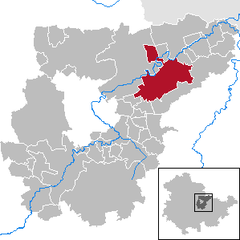Apolda
Apolda (German: [aˈpɔlda] ⓘ) is a town in central Thuringia, Germany, the capital of the Weimarer Land district. It is situated in the center of the triangle Weimar–Jena–Naumburg near the river Ilm, c. 15 kilometres (9 miles) east by north from Weimar. Apolda station lies on the Halle–Bebra railway, which is part of the main line from Berlin to Frankfurt.
You can help expand this article with text translated from the corresponding article in German. (December 2012) Click [show] for important translation instructions.
|




